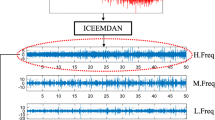Abstract
It has been established that turning process on a lathe exhibits low dimensional chaos. This study reports the results of nonlinear time series analysis applied to sensor signals captured real time. The purpose of this chaos analysis is to differentiate three levels of flank wears on cutting tool inserts—fresh, partially worn and fully worn—utilizing the single value index extracted from the reconstructed chaotic attractor; the correlation dimension. The analysis reveals distinguishable dynamics of cutting characterized by different values for the dimension of the attractor when different quality tool inserts are used. This dependence can be effectively utilized as one of the indicators in tool condition monitoring in a lathe. This paper presents the experimental results and shows that tool vibration signals can transmit tool wear conditions reliably.









Similar content being viewed by others
References
Bukkapatnam STS, Lakhtakia A, Kumara SRT (1995a) Analysis of sensor signals shows turning on a lathe exhibits low-dimensional chaos. Phys Rev E Stat Phys Plasmas Fluids Relat Interdiscip Top 52(3):2375–2387. doi:10.1103/PhysRevE.52.2375
Bukkapatnam STS, Lakhtakia A, Kumara SRT, Satapathy G (1995b) Characterization of nonlinearity of cutting tool vibrations and chatter. In: ASME symposium on intelligent manufacturing and material processing, vol 69, pp 1207–1223
Bukkapatnam STS, Lakhtakia A, Kumara SRT (2000) Fractal estimation of flank wear in turning. J Dyn Syst Meas Control 122:89–94. doi:10.1115/1.482446
Dan L, Mathew J (1990) Tool wear and failure monitoring techniques for turning—a review. Int J Mach Tools Manuf 30(4):579–598. doi:10.1016/0890-6955(90)90009-8
Dimla DE (2000) Sensor signals for tool-wear monitoring in metal cutting operations—a review of methods. Int J Mach Tools Manuf 40:1073–1098. doi:10.1016/S0890-6955(99)00122-4
Ding M, Grebogi C, Ott E, Sauer T, Yoke JA (1993) Plateau onset for correlation dimension: when does it occur? Phys Rev Lett 70(25):3872–3875. doi:10.1103/PhysRevLett.70.3872
Franca LF, Savi MA (2000a) On the time series determination of Lyapunov exponents applied to the nonlinear pendulum analysis. In: Non linear dynamics, chaos. Contr Their Appl Eng Sci ABCM 5:356–366
Franca LF, Savi MA (2000b) Estimating fractal dimension from time series: case study of nonlinear pendulum. In: Non linear dynamics, chaos. Contr Their Appl Eng Sci ABCM 5:345–355
Fraser AM, Swinney HL (1986) Independent coordinates for strange attractors from mutual information. Phys Rev A 33:1134–1140. doi:10.1103/PhysRevA.33.1134
Govekar E, Grabec I (1998) In: Monitoring and automatic supervision in manufacturing, 5th international conference, Warsaw, p 74
Govekar E, Gradisek J, Grabec I (2000) Analysis of acoustic emission signals and monitoring of machining processes. Ultrasonics 38:598–603. doi:10.1016/S0041-624X(99)00126-2
Grassberger P, Procaccia I (1983) Characterization of strange attractors. Phys Rev Lett 50:346–349. doi:10.1103/PhysRevLett.50.346
Kang MC, Kim JS, Kim JH (2001) A monitoring technique using a multi-sensor in high speed machining. J Mater Process Technol 113:331–336. doi:10.1016/S0924-0136(01)00698-7
Kantz H, Schreiber T (1997) Nonlinear time series analysis. Cambridge University Press, UK
Kennel MB, Brown R, Abarbanel HDI (1992) Determining embedding dimension from phase-space reconstruction using a geometrical construction. Phys Rev A 25:3403–3411. doi:10.1103/PhysRevA.45.3403
Mann HB, Whitney DR (1947) On a test of whether one of two random variables is stochastically larger than the other. Ann Math Stat 18:50–60. doi:10.1214/aoms/1177730491
Moon FC (1987) Chaotic vibrations: an introduction for applied scientists and engineers. Wiley, New York
Moon F (1990) Chaotic and fractal dynamics. Springer, New York
Packard NH, Crutchfield JP, Farmer JD, Shaw RS (1980) Geometry from a time series. Phys Rev Lett 45(9):712–716. doi:10.1103/PhysRevLett.45.712
Reiss JD (2001) The analysis of chaotic time series. Ph.D. thesis, Georgia institute of Technology
Sokolowski A, Kosmol J (2001) Selected examples of cutting process monitoring and diagnostics. J Mater Process Technol 113:322–330. doi:10.1016/S0924-0136(01)00623-9
Takens F (1980) Detecting strange attractors in turbulence. In: Dynamical systems and turbulence, Warwick. Lecture notes in mathematics, vol 898. Springer, Berlin, pp 366–81
Acknowledgments
V. G. Rajesh thanks the Institute of Human Resources Development, Trivandrum for supporting his studies. We acknowledge with thanks the All India Council for Technical Education, New Delhi for the financial assistance being received for this work under RPS Project No. PLB1/6723/05.
Author information
Authors and Affiliations
Corresponding author
Rights and permissions
About this article
Cite this article
Rajesh, V.G., Narayanan Namboothiri, V.N. Flank wear detection of cutting tool inserts in turning operation: application of nonlinear time series analysis. Soft Comput 14, 913–919 (2010). https://doi.org/10.1007/s00500-009-0466-5
Published:
Issue Date:
DOI: https://doi.org/10.1007/s00500-009-0466-5




